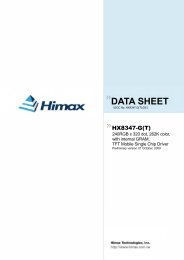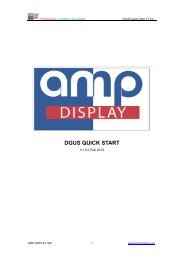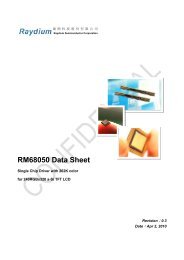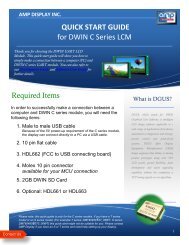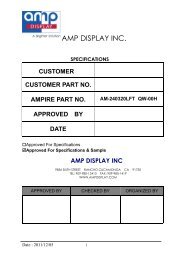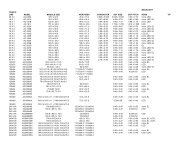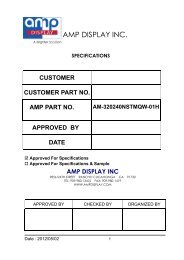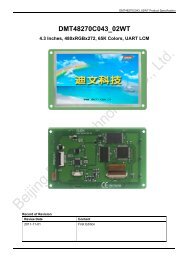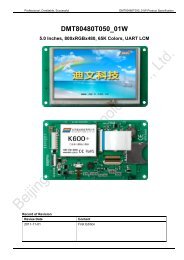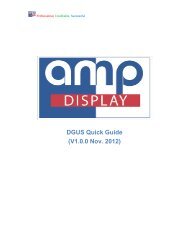AM-480272H2TMQW-A0H-F - AMP Display
AM-480272H2TMQW-A0H-F - AMP Display
AM-480272H2TMQW-A0H-F - AMP Display
You also want an ePaper? Increase the reach of your titles
YUMPU automatically turns print PDFs into web optimized ePapers that Google loves.
<strong>AM</strong>P DISPLAY INC.<br />
SPECIFICATIONS<br />
CUSTOMER<br />
CUSTOMER PART NO.<br />
<strong>AM</strong>P PART NO<br />
<strong>AM</strong>-<strong>480272H2TMQW</strong>-<strong>A0H</strong><br />
APPROVED BY<br />
DATE<br />
Approved For Specifications<br />
Approved For Specifications & Sample<br />
<strong>AM</strong>P DISPLAY INC<br />
9856 SIXTH STREET RANCHO CUC<strong>AM</strong>ONGA CA 91730<br />
TEL: 909-980-13410 FAX: 909-980-1419<br />
WWW.<strong>AM</strong>PDISPLAY.COM<br />
APPROVED BY CHECKED BY ORGANIZED BY<br />
Date: 2010/07/27 1
RECORD OF REVISION<br />
Revision Date Page Contents Editor<br />
2010/8/27<br />
2012/4/23 4<br />
New Release<br />
Remove the Power Voltage<br />
Patrick<br />
Leo<br />
Date: 2010/8/27 2
1. FEATURES<br />
(1) Construction : a-Si TFT-LCD with driving system, White LED Backlight.<br />
(2) LCD type : Transmissive , Normally White<br />
(3) Number of the Colors : 16.7M colors (R,G,B 8 bit digital each)<br />
(4) RGB Interface 40 pin.<br />
(5) LCD Power Supply Voltage : 3.3V single power input<br />
(6) Interface mode: TTL RGB interface. Sync mode.<br />
(7) Reflective ratio 0.5% ~ 2%<br />
The timing control IC both supports DE mode and Sync mode timing. The module default<br />
is Sync mode.<br />
Mode Hardware PIN32: PIN33: PIN37: Remark<br />
Setting<br />
HSYNC VSYNC NC(DE)<br />
Sync Mode R8 NC HSYNC<br />
needed<br />
VSYNC<br />
needed<br />
NC Default<br />
DE pull low internally.<br />
DE mode R8= 0 ohm HSYNC<br />
don’t<br />
needed<br />
VSYNC<br />
don’t<br />
needed<br />
DE<br />
needed<br />
Option<br />
In DE mode, only DE signal is<br />
needed. HSYNC and VSYNC<br />
pull High internally.<br />
It is necessary to keep tvp+tvb=12 and thp+thb=43 in SYNC mode. DE mode is unnecessary.<br />
If you need the DE mode for mass production, please contact us to apply a part number for<br />
this option. (R8= 0 ohm).<br />
Date: 2010/8/27 3
2. PHYSICAL SPECIFICATIONS<br />
Item Specifications unit<br />
<strong>Display</strong> size (diagonal) 4.3 inch<br />
Resolution 480RGB (W) x 272(H) dots<br />
<strong>Display</strong> area 98.7 (W) x57.5 (H) mm<br />
Pixel pitch 0.198 (W) x 0.198 (H) mm<br />
Overall dimension 105.5(W)x114.05(H)x3.95(D) mm<br />
Color configuration<br />
View Direction (Gray Inversion)<br />
R.G.B Vertical stripe<br />
6 o’clock<br />
3. ABSOLUTE MAXIMUM RATINGS<br />
Values<br />
item<br />
Symbol<br />
Min Max<br />
Unit<br />
Remark<br />
Power Supply for logic VCC -0.3 5.0 V GND=0<br />
Operation Temperature<br />
(Ambient) TOP -20 70 ℃<br />
Storage Temperature<br />
(Ambient) TST -30 80 ℃ Note 1<br />
LED Forward current If 20 mA OneLED/Note2<br />
LED Power Dissipation Pd 64 mW One LED<br />
*TFT LCD Ratings<br />
Note 1: Hsync, Vsync, DEN, DCLK, R0~R7, G0~G7, B0~B7<br />
Note 2: Background color changes slightly depending on ambient temperature. This<br />
phenomenon is reversible.<br />
Date: 2010/8/27 4
4. OPTICAL CHARACTERISTICS<br />
Item Symbol Condition Min. Typ. Max. Unit Note<br />
Response Time T r +T f - 40 ms (3)<br />
Θ=Φ=0°<br />
Contrast ratio<br />
CR<br />
250 - - (1)<br />
Viewing Vertical Θ 90. -<br />
CR≧<br />
10<br />
Angle Horizontal Φ<br />
130 -<br />
Deg. (4)<br />
Luminance L -- 500 -- cd/m 2 (2)<br />
Θ=Φ=0°<br />
Color<br />
Wx<br />
0.301<br />
White<br />
(2)(3)<br />
chromaticity<br />
Wy<br />
0.339<br />
NOTE :<br />
Measure Condition:IL= 20.0mA<br />
Measure Item Definition as follow:<br />
(1)Definition of Contrast Ratio:(Measured by BM-7 (TOPCON) [dark room] )<br />
Contrast Ratio (CR)= (White) Luminance of ON ÷ (Black) Luminance of OFF<br />
(2) Definition of Center Luminance &Luminance Uniformity:(Measured by BM-7<br />
(TOPCON) [dark room] )<br />
Center Luminance:Measure luminance on Point No5 as figure 9-1.<br />
Luminance Uniformity:Measure maximum luminance(L(MAX) )and minimum<br />
luminance (L(MIN) )on the 9 points as figure 9-1.<br />
L = [L(MIN)/L(MAX)]×100% △<br />
(3) Response Time (White - Black)<br />
Date: 2010/8/27 5
(4)Definition of Viewing Angle () :(by EZ-CONTRAST (ELDIM) in the dark room. )<br />
Date: 2010/8/27 6
5. ELECTRICAL CHARACTERISTICS<br />
LCD driving<br />
Item Symbol Min. Typ. Max. Unit Note<br />
Power supply voltage VDD 3.0 3.3 3.6 V<br />
Input voltage for<br />
logic<br />
H Level V IH 0.8 VDD -- VDD V<br />
L Level V IL 0 -- 0.2 VDD V<br />
(1)<br />
Power Supply current IDD -- 45 -- mA (2)<br />
Note 1: Hsync, Vsync, DEN, DCLK, R0~R5, G0~G5, B0~B5<br />
Note 2: fV =60Hz , Ta=25℃ , <strong>Display</strong> pattern : All Black<br />
LED back light specification<br />
Item Symbol Conditions MIN. TYP. MAX. Unit<br />
Forward voltage V f I f =18mA 23.1 25.2 V<br />
Forward current I f 7-chip serial - 18 20 mA<br />
Uniformity (with L/G) - I f =18mA 75%*1 - -<br />
Life Time<br />
(LED Dice)<br />
Luminous color<br />
Chip connection<br />
-<br />
Ta=25°C,<br />
IF=20mA<br />
17.7K Hrs<br />
White<br />
7 chip serial connection<br />
• The constant current source is needed for white LED back-light driving. When LCM is<br />
operated over 60 deg.C ambient temperature, the I LED of the LED back-light should be<br />
adjusted to 15mA max<br />
Allowable Forward Current IF (mA)<br />
Pin definition of Backlight<br />
Pin no Symbol Function<br />
1 LED_K LED Cathode<br />
2 NC Keep NC<br />
3 NC Keep NC<br />
4 LED_A LED Anode<br />
Date: 2010/8/27 7
6. BLOCK DIAGR<strong>AM</strong><br />
Date: 2010/8/27 8
7. TFT LCD Panel FPC Descriptions<br />
Pin no Symbol Function Remark<br />
1 GND Ground<br />
2 GND Ground<br />
3 VCC Power Supply(3.3V)<br />
4 VCC Power Supply(3.3V)<br />
5 R0 Red Data Bit 0<br />
6 R1 Red Data Bit 1<br />
7 R2 Red Data Bit 2<br />
8 R3 Red Data Bit 3<br />
9 R4 Red Data Bit 4<br />
10 R5 Red Data Bit 5<br />
11 R6 Red Data Bit 6<br />
12 R7 Red Data Bit 7<br />
13 G0 Green Data Bit 0<br />
14 G1 Green Data Bit 1<br />
15 G2 Green Data Bit 2<br />
16 G3 Green Data Bit 3<br />
17 G4 Green Data Bit 4<br />
18 G5 Green Data Bit 5<br />
19 G6 Green Data Bit 6<br />
20 G7 Green Data Bit 7<br />
21 B0 Blue Data Bit 0<br />
22 B1 Blue Data Bit 1<br />
23 B2 Blue Data Bit 2<br />
24 B3 Blue Data Bit 3<br />
25 B4 Blue Data Bit 4<br />
26 B5 Blue Data Bit 5<br />
27 B6 Blue Data Bit 6<br />
28 B7 Blue Data Bit 7<br />
29 GND Ground<br />
30 DCLK Dot Data Clock<br />
31 DISP <strong>Display</strong> ONOFF<br />
32 Hsync<br />
SYNC mode: Horizontal Sync Input<br />
DE mode: no function. Can be floating.<br />
(Note1)<br />
33 Vsync<br />
SYNC mode: Vertical Sync Input<br />
(Note1)<br />
DE mode: no function. Can be floating.<br />
34 NC Not Connection<br />
35 NC Not Connection<br />
36 NC Not Connection<br />
37 NC (DE)<br />
SYNC mode : Not Connection<br />
DE mode: DE signal input<br />
(Note1)<br />
38 Test1 Not Connection<br />
39 Test2 Not Connection<br />
40 Test3 Not Connection<br />
(Note1): The module is SYNC mode, if R8 is open. The module is DE mode, if R8 is 0 ohm.<br />
Date: 2010/8/27 9
8. INPUT SIGNAL<br />
8.1 Parallel RGB input timing Chart<br />
Date: 2010/8/27 10
8.2 Timing Specification<br />
Parallel RGB input timing requirement<br />
PAR<strong>AM</strong>ETER Symbol Min. Typ. Max. Unit<br />
Clock cycle 1/t C *1 9 15 MHz<br />
Hsync cycle 1/f H 17.14 - KHz<br />
Vsync cycle 1/f V 59.94 - Hz<br />
Horizontal Signal<br />
Horizontal cycle th *2 525 525 605 CLK<br />
Horizontal display period thd 480 480 480 CLK<br />
Horizontal front porch thf 2 2 82 CLK<br />
Horizontal pulse width thp 2 41 41 CLK<br />
Horizontal back porch thb 2 2 41 CLK<br />
Vertical Signal<br />
Vertical cycle tv 285 286 399 H<br />
Vertical display period tvd 272 272 272 H<br />
Vertical front porch tvf 1 2 227 H<br />
Vertical pulse width tvp 1 10 11 H<br />
Vertical back porch tvb 1 2 11 H<br />
Note:<br />
1. Unit: CLK=1/ fCLK , H=th<br />
2.Parallel interface. Clock frequency and horizontal signal parameters are tripled in<br />
serial interface. The Maximum clock frequency of serial interface is 33MHz<br />
3. It is necessary to keep tvp+tvb=12 and thp+thb=43 in SYNC mode. DE mode is<br />
unnecessary.<br />
8.3 Timing Chart 2<br />
Input setup timing requirement<br />
PAR<strong>AM</strong>ETER Symbo Min. Typ. Max. Unit<br />
l<br />
DISP setup time tdiss 10 - - ns<br />
DISP hold time tdish 10 - ns<br />
Clock period PW CLK *1 66.7 - - ns<br />
Clock pulse high period PWH *1 26.7 - - ns<br />
Clock pulse low period PWL *1 26.7 - - ns<br />
Hsync setup time t hs 10 - - ns<br />
Hsync hold time t hh 10 - ns<br />
Data setup time t ds 10 - - ns<br />
Data hold time t dh 10 - - ns<br />
DE setup time t des 10 - - ns<br />
DE hold time t deh 10 - - ns<br />
Vsync setup time t vhs 10 - - ns<br />
Vsync hold time t vhh 10 - - ns<br />
Note<br />
1. For parallel interface, maximum clock frequency is 15MHz.<br />
2. tr, tf is defined 10% to 90% of signal amplitude.<br />
Date: 2010/8/27 11
8.4 Input setup timing Chart<br />
Date: 2010/8/27 12
9. Color Data Assignment<br />
Date: 2010/8/27 13
10. QUALITY AND RELIABILITY<br />
10.1Test Conditions<br />
Tests should be conducted under the following conditions :<br />
Ambient temperature : 25 5C<br />
Humidity<br />
: 60 25% RH.<br />
10.2 Sampling Plan<br />
Sampling method shall be in accordance with MIL-STD-105E , level II, normal single<br />
sampling plan .<br />
10.3 Acceptable Quality Level<br />
A major defect is defined as one that could cause failure to or materially reduce the<br />
usability of the unit for its intended purpose. A minor defect is one that does not materially<br />
reduce the usability of the unit for its intended purpose or is an infringement from<br />
established standards and has no significant bearing on its effective use or operation.<br />
10.4 Appearance<br />
An appearance test should be conducted by human sight at approximately 30 cm<br />
distance from the LCD module under florescent light. The inspection area of LCD panel<br />
shall be within the range of following limits.<br />
Date: 2010/8/27 14
11. Incoming Inspection Standard<br />
No. Item Criterion for defects<br />
Class<br />
of<br />
Defect<br />
Accept<br />
able<br />
level<br />
1 Non display No non display is allowed Major 0.4<br />
2<br />
Irregular<br />
operation<br />
No irregular operation is allowed Major 0.4<br />
3 Short No short are allowed Major 0.4<br />
4 Open<br />
Any segments or common patterns that don’t activate<br />
are rejectable.<br />
Major 0.4<br />
5<br />
Black/White<br />
spot (I)<br />
Size D (mm)<br />
D < 0.1<br />
0.1 < D < 0.3<br />
0.3 < D<br />
Acceptable number<br />
Ignore<br />
4 ※1<br />
0<br />
Minor 1.5<br />
6 Dot Defect<br />
7 Back Light<br />
※1: The distance of two defects must be more than 20mm.<br />
Bright dot<br />
Dark dot<br />
N≦2<br />
N≦4<br />
Total dot defect<br />
N≦6<br />
(Bright dot + Dark dot)<br />
Minimum distance between<br />
L≧5mm<br />
dark dot and dark dot<br />
1. No Lighting is rejectable<br />
2. Flickering and abnormal lighting are rejectable<br />
Minor 1.5<br />
Major 0.4<br />
8 <strong>Display</strong> pattern Unit:mm<br />
A B<br />
D E<br />
0.30 0 < C 0.25<br />
2<br />
2<br />
F G<br />
0.25<br />
2<br />
Note: 1. Acceptable up to 3 damages<br />
2. NG if there’re to two or more pinholes per dot<br />
Minor 1.5<br />
9<br />
Blemish &<br />
Foreign matters<br />
Size:<br />
A B<br />
D <br />
2<br />
Size D (mm)<br />
D < 0.15<br />
0.15 < D < 0.20<br />
0.20 < D < 0.30<br />
0.30 < D<br />
Acceptable number<br />
Ignore<br />
3<br />
2<br />
0<br />
Minor 1.5<br />
Date: 2010/8/27 15
10<br />
Scratch on<br />
Polarizer<br />
Width (mm) Length (mm) Acceptable number<br />
W≦0.05 and L≦ 0.3<br />
Ignore<br />
0.05
[Note1] W : Width[mm], L : Length[mm], N : Number, φ: Average Diameter<br />
[Note2] Bright dot is defined through 6% transmission ND Filter as following.<br />
[Note3]<br />
C Area: Center of display area<br />
C Area: Outer of display area<br />
[Note4]<br />
Judge defect dot and adjacent dot as following. Allow below (as A, B, C and D status)<br />
adjacent defect dots, including bright and dart adjacent dot. And they will be counted 2<br />
defect dots in total quantity.<br />
(1) The defects that are not defined above and considered to be problem shall be reviewed<br />
and discussed by both parties.<br />
(2) Defects on the Black Matrix, out of <strong>Display</strong> area, are not considered as a defect or<br />
counted.<br />
Date: 2010/8/27 17
12. Reliability Test<br />
Test Item Test Conditions Note<br />
High Temperature Operation<br />
Low Temperature Operation<br />
703C , t=96 hrs<br />
-203C , t=96 hrs<br />
High Temperature Storage 803C , t=96 hrs 1,2<br />
Low Temperature Storage -303C , t=96 hrs 1,2<br />
Thermal Shock Test<br />
-30C ~ 25C ~ 80C<br />
30 m in. 5 min. 30 min. ( 1 cycle )<br />
Total 5 cycle<br />
Humidity Test 40 C, Humidity 90%, 96 hrs 1,2<br />
Vibration Test (Packing)<br />
Sweep frequency : 10 ~ 55 ~ 10 Hz/1min<br />
Amplitude : 0.75mm<br />
Test direction : X.Y.Z/3 axis<br />
2<br />
Duration : 30min/each axis<br />
Note 1 : Condensation of water is not permitted on the module.<br />
Note 2 : The module should be inspected after 1 hour storage in normal conditions<br />
(15-35°C , 45-65%RH).<br />
Definitions of life end point :<br />
• Current drain should be smaller than the specific value.<br />
• Function of the module should be maintained.<br />
• Appearance and display quality should not have degraded noticeably.<br />
• Contrast ratio should be greater than 50% of the initial value.<br />
1,2<br />
Date: 2010/8/27 18
13. USE PRECAUTIONS<br />
13.1 Handling precautions<br />
1) The polarizing plate may break easily so be careful when handling it. Do not touch, press<br />
or rub it with a hard-material tool like tweezers.<br />
2) Do not touch the polarizing plate surface with bare hands so as not to make it dirty. If the<br />
surface or other related part of the polarizing plate is dirty, soak a soft cotton cloth or<br />
chamois leather in benzene and wipe off with it. Do not use chemical liquids such as<br />
acetone, toluene and isopropyl alcohol. Failure to do so may bring chemical reaction<br />
phenomena and deteriorations.<br />
3) Remove any spit or water immediately. If it is left for hours, the suffered part may deform<br />
or decolorize.<br />
4) If the LCD element breaks and any LC stuff leaks, do not suck or lick it. Also if LC stuff is<br />
stuck on your skin or clothing, wash thoroughly with soap and water immediately.<br />
13.2 Installing precautions<br />
1) The PCB has many ICs that may be damaged easily by static electricity. To prevent<br />
breaking by static electricity from the human body and clothing, earth the human body<br />
properly using the high resistance and discharge static electricity during the operation. In<br />
this case, however, the resistance value should be approx. 1MΩ and the resistance<br />
should be placed near the human body rather than the ground surface. When the indoor<br />
space is dry, static electricity may occur easily so be careful. We recommend the indoor<br />
space should be kept with humidity of 60% or more. When a soldering iron or other<br />
similar tool is used for assembly, be sure to earth it.<br />
2) When installing the module and ICs, do not bend or twist them. Failure to do so may<br />
crack LC element and cause circuit failure.<br />
3) To protect LC element, especially polarizing plate, use a transparent protective plate (e.g.,<br />
acrylic plate, glass etc) for the product case.<br />
4) Do not use an adhesive like a both-side adhesive tape to make LCD surface (polarizing<br />
plate) and product case stick together. Failure to do so may cause the polarizing plate to<br />
peel off.<br />
13.3 Storage precautions<br />
1) Avoid a high temperature and humidity area. Keep the temperature between 0°C and<br />
35°C and also the humidity under 60%.<br />
2) Choose the dark spaces where the product is not exposed to direct sunlight or<br />
fluorescent light.<br />
3) Store the products as they are put in the boxes provided from us or in the same<br />
conditions as we recommend.<br />
Date: 2010/8/27 19
13.4 Operating precautions<br />
1) Do not boost the applied drive voltage abnormally. Failure to do so may break ICs. When<br />
applying power voltage, check the electrical features beforehand and be careful. Always<br />
turn off the power to the LC module controller before removing or inserting the LC<br />
module input connector. If the input connector is removed or inserted while the power is<br />
turned on, the LC module internal circuit may break.<br />
2) The display response may be late if the operating temperature is under the normal<br />
standard, and the display may be out of order if it is above the normal standard. But this<br />
is not a failure; this will be restored if it is within the normal standard.<br />
3) The LCD contrast varies depending on the visual angle, ambient temperature, power<br />
voltage etc. Obtain the optimum contrast by adjusting the LC dive voltage.<br />
4) When carrying out the test, do not take the module out of the low-temperature space<br />
suddenly. Failure to do so will cause the module condensing, leading to malfunctions.<br />
5) Make certain that each signal noise level is within the standard (L level: 0.2Vdd or less<br />
and H level: 0.8Vdd or more) even if the module has functioned properly. If it is beyond<br />
the standard, the module may often malfunction. In addition, always connect the module<br />
when making noise level measurements.<br />
6) The CMOS ICs are incorporated in the module and the pull-up and pull-down function is<br />
not adopted for the input so avoid putting the input signal open while the power is ON.<br />
7) The characteristic of the semiconductor element changes when it is exposed to light<br />
emissions, therefore ICs on the LCD may malfunction if they receive light emissions. To<br />
prevent these malfunctions, design and assemble ICs so that they are shielded from light<br />
emissions.<br />
8) Crosstalk occurs because of characteristics of the LCD. In general, crosstalk occurs<br />
when the regularized display is maintained. Also, crosstalk is affected by the LC drive<br />
voltage. Design the contents of the display, considering crosstalk.<br />
13.5 Other<br />
1) Do not disassemble or take the LC module into pieces. The LC modules once<br />
disassembled or taken into pieces are not the guarantee articles.<br />
2) The residual image may exist if the same display pattern is shown for hours. This<br />
residual image, however, disappears when another display pattern is shown or the drive<br />
is interrupted and left for a while. But this is not a problem on reliability.<br />
3) <strong>AM</strong>IPRE will provide one year warrantee for all products and three months warrantee for<br />
all repairing products.<br />
Date: 2010/8/27 20
14 OUTLINE DIMENSION<br />
Date: 2010/8/27 21




